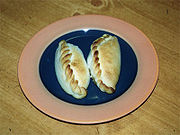
Salteñas
Encyclopedia
| Salteñas |
|---|
 |
A salteña is a type of Bolivian
Bolivian
Bolivian may refer to:* Something of, or related to Bolivia** Demographics of Bolivia** Culture of BoliviaBolivian is a citizen of Bolivia...
baked empanada
Empanada
An empanada is a stuffed bread or pastry baked or fried in many countries in Latin America, Southern Europe and parts of Southeast Asia. The name comes from the verb empanar, meaning to wrap or coat in bread. Empanada is made by folding a dough or bread patty around the stuffing...
.
Salteñas are savory pastries filled with beef, pork or chicken mixed in a sweet, slightly spicy or very spicy sauce, and sometimes also containing peas, potatoes and other ingredients. There are also some vegetarian versions available for sale at certain restaurants.
Typically salteñas can be found in any town or city throughout the country, but each area has its variations; Cochabamba
Cochabamba
Cochabamba is a city in central Bolivia, located in a valley bearing the same name in the Andes mountain range. It is the capital of the Cochabamba Department and is the fourth largest city in Bolivia with an urban population of 608,276 and a metropolitan population of more than 1,000,000 people...
and Sucre
Sucre
Sucre, also known historically as Charcas, La Plata and Chuquisaca is the constitutional capital of Bolivia and the capital of the department of Chuquisaca. Located in the south-central part of the country, Sucre lies at an elevation of 2750m...
claim to have the best version of this snack, and many will go out of their way to try the variation from Potosí
Potosí
Potosí is a city and the capital of the department of Potosí in Bolivia. It is one of the highest cities in the world by elevation at a nominal . and it was the location of the Spanish colonial mint, now the National Mint of Bolivia...
. In La Paz
La Paz
Nuestra Señora de La Paz is the administrative capital of Bolivia, as well as the departmental capital of the La Paz Department, and the second largest city in the country after Santa Cruz de la Sierra...
, it is a tradition to enjoy salteñas as a mid-morning snack, although vendors often start selling salteñas very early in the morning. The pastries are sold anywhere from 7am to noon. What is astonishing is how quickly they are sold; many outlets are sold out by mid-morning.
History
Historian Antonio Paredes CandiaAntonio Paredes Candia
Antonio Paredes Candia was a Bolivian writer and historian. He published a number of notable books on Bolivian folklore.-Selected works:*"Literatura Folclórica"*"El Apodo en Bolivia"...
states that during the early 19th century, Juana Manuela Gorriti
Juana Manuela Gorriti
Juana Manuela Gorriti was an Argentine writer with extensive political and literary links to Bolivia and Peru.-Biography:Juana Manuela Gorriti was born in Salta near the Bolivian border. She came from a wealthy upper class family, and attended a convent school when she was eight...
was the first person to create the current version of this product. This lady later married Presidente Manuel Isidoro Belzu
Manuel Isidoro Belzu
Manuel Isidoro Belzu Humerez was president of Bolivia from 1848 to 1855.-Early life and education:Born in La Paz, Bolivia to humble mestizo parents, Belzu was educated by Franciscan friars.-Early career:...
. Gorriti was born in Salta, Argentina and was exiled to Tarija, Bolivia
Tarija, Bolivia
Tarija or San Bernardo de la Frontera de Tarixa is a city in southern Bolivia. Founded in 1574, Tarija is both the capital and largest city within the Tarija Department, with an airport offering regular service to primary Bolivian cities, as well as a regional bus terminal with domestic and...
during the Juan Manuel de Rosas
Juan Manuel de Rosas
Juan Manuel de Rosas , was an argentine militar and politician, who was elected governor of the province of Buenos Aires in 1829 to 1835, and then of the Argentine Confederation from 1835 until 1852...
dictatorship. The Gorriti family endured extreme poverty, and they came up with the recipe in the early 19th century in order to make a living. A variation of these pastries was known at the time throughout most of Europe.
The product, nicknamed "salteña", became very popular. Candia states that it was common to say to kids: "Ve y recoge una empanada de la salteña" ("go and pick up an empanada from the woman from Salta"). In time most forgot the name Manuela Gorriti, but not the nickname. Eventually the salteñas left the city of Tarija and became a Bolivian tradition.
Other ingredients included in a salteña are eggs, olives, or raisins.
Another characteristic is that they are juicy, like a stew in a pastry. They are more football shaped than flat like empanadas. The trick to eating them is to hold them upright, nibble the top corner and work your way down without spilling any of the hot juices. The juiciness is achieved by making a stew out of all the ingredients and adding gelatin, so that the stew hardens in the refrigerator, and then slowly melts when they are baked. This ensures that the dough does not get soggy even while providing a very juicy filling.

